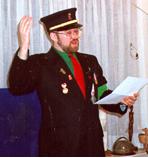History of the Monarchy
Þistoria dal Monarc’hà
The Reign of Robert I

El Röin da Róibeard Pirmalaiset
On 26 December 1979, Robert Ben Madison, a 14-year old high school student in Milwaukee, Wisconsin, declared his bedroom to be an independent sovereign state: the Kingdom of Talossa.
He took the Throne as King Robert I.
Beginning in 1981, other people were admitted to the RT (Regipäts Talossan; Kingdom of Talossa) as citizens. Democratic elections began in 1981 and the nation became a constitutional monarchy in 1985.
The Reign of Robert II
El Röin da Róibeard Secund
Robert Dobberpuhl became King Robert II and served a 47 day reign in early 1987. His predecessor had abdicated in favour of the second King Robert while the nation was experiencing a strong feeling for abolition of the monarchy. In a referendum, however, the installation of Robert II as King passed with just over half of the vote, and the monarchy was continued. However, The new King failed to endear himself to the citizenry and the People United for No King (PUNK) party swept the next election before going on to legislatively terminate King Robert II’s reign.
Interregnum
Interegneu
The nation was in a period of crisis from 29 March until 24 August 1987 while a royal personage for the nation was sought. King Robert I, at this time, chose not to heed the calls from various quarters for him to reassume the Throne. During this interregnum, the nation was known as “The Peculiar Republic of Talossa.”
The Reign of Florence I

El Röin da Fiorença Pirmalaiset
The search for a suitable monarch ended when Florence I (Florence Yarney) was acclaimed Sovereign and crowned on 24 August 1987. She reigned until renouncing the Crown in favour of the restoration of King Robert I on 27 February 1988.
Her brief reign saw great strides in the political life of the nation, including the creation of the legislative journal, The Clark. During her reign, she was referred to as “King Florence.”
The Restoration of Robert I

La Restoraziun da Róibeard Pirmalaiset
King Robert I was returned to the throne in early 1988, and led the effort to establish a new constitution, which was adopted later that year.
This 1988 version of the constitution was replaced in 1997 by a public referendum. The new Organic Law further developed the democratic nature of Talossa.
King Robert I was always involved in various political parties. However, the Organic Law now prohibited the King from holding the chief offices of political power in Talossa and in 2003 he left the Ziu for good.
King Robert I reigned until his abdication in favour of King Louis on 16 August 2005.
The Regency of Louis I

La Rexhençù da Luïç Pirmalaiset
King Louis ascended to the throne coïncident with the ascension of the star Canopus (Alpha Carinae) on 16 August 2005. This is significant as Talossa’s mythical Berber forebears on the Canary Islands marked the beginning of their lunar year with the ascension of Canopus. Due to His Majesty being a minor, the business of state was conducted by an appointed Regent, G. Rajala, who held the royal powers. King Louis abdicated the throne on 29 November 2006 by the act of his legal guardian (the two Houses of the Ziu, together with the Uppermost Cort).
Interregnum
Interegneu
From 29 November 2006 until 14 March 2007 Talossa was without a King. The Uppermost Cort acted as the Council of Regency until the Ziu, in accordance with its Organic responsibility, elected a King and the choice was ratified by the people.
The Reign of John I

El Röin d’Ian Pirmalaiset
After the interregnum caused by the end of the House of Rouergue, John I ascended to the throne on 14 March 2007. King John was elected by the Ziu on 21 February 2007 and the election was ratified by the people of Talossa in a special referendum. King John was chosen for his selfless devotion to the nation in such positions of high responsibility as Secretary of State, Chancellor of the Royal Talossan Bar, Senator and Herald in the College of Arms. His Majesty maintains an active interest in the national language and heritage and reigns to this day.
The King of Talossa
Txec





